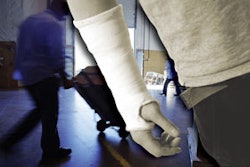Rising medical expenses are the culprits driving up Workers’ Compensation costs. While it’s true that Workers’ Comp rates are mostly flat or going down, any savings is being more than eaten up by higher medical bills.
With the possible exception of safety issues, many employers feel that Workers’ Comp costs are beyond their control. As it turns out, they can play a key role in controlling medical costs.
Here are six actions employers can take to make certain medical costs are appropriate:
1. Medical costs are the leading driver of Workers’ Compensation costs. As a percentage of total comp claims, medical costs rose from 46% in 1988 to 58% in 2009, the last year for which fully adjusted data is available.
A workforce plagued by obesity, diabetes, and poor health habits coupled with demographic trends of an aging workforce that takes longer to heal, offer little relief to combat this disconcerting trend.
Action: All bills should be carefully checked as mistakes, inaccurate coding, duplication and fraud happen. Beyond checking the bills, it’s vital to ensure that employees receive the most appropriate—and most cost-effective—care, aimed at returning the employee to work. Established relationships with physicians and clinics trained in occupational medicine will help ensure early, effective treatment and positive outcomes.
2. Workers’ Comp hospital costs inflation high. A recent article in Risk and Insurance by Peter Rousmaniere, an expert on the Workers' Compensation industry, notes that the rate of inflation for hospital costs appears to be among the highest for Workers' Comp claims payers. Bill-review professionals say that hospitals take advantage of flawed fee schedules, employing experts to maximize billing.
This is consistent with an NCCI Holdings, Inc. 2010 report that found the proportion of Workers’ Compensation medical costs subject to physician fee schedules is declining as medical providers shift from charging private practice fees to billing for procedures through hospitals or other facilities that employ them. Billing by hospitals and the other facilities may not fall under a Workers’ Comp fee schedule.
Action: Partnering with the right medical providers is key. Employees who are injured at work are entitled to the highest quality medical care, aimed at returning employees safely back to productive work. There are significant differences between occupational health delivery systems and the general medical community.
Establishing relationships with physicians or clinics that use proper diagnostic evaluation and evidenced-based treatment guidelines will improve outcomes, reduce costs and help workers return to their jobs quickly and safely. Understanding red flags of inappropriate treatment and addressing the issues quickly will help stop costs from spiraling.
3. Emergency room wait times put safety at risk. In addition to having costs four or five times higher than clinic or office visits, emergency rooms are jeopardizing patient safety due to high wait times, the American College of Emergency Physicians (ACEP) warns.
The increasing number of patients relying on ER for medical care because they lack health care coverage caused the average wait time to rise to 4 hours, 7 minutes.
Almost 40% of hospital ERs exceed or are at capacity. ACEP said health care reform legislation won’t improve the situation, pointing out that Massachusetts, which passed health care reform in 2006, has seen an increase in ER visits.
Action: Only life threatening emergencies should be treated at an Emergency Room. Having a clearly defined process for medical evaluations, treatment and care when an injury occurs is critical to controlling costs.
4. Misuse and abuse of prescription drugs on the rise. Prescription drugs play a significant role in Workers’ Compensation and while medications can replace expensive surgeries or other invasive procedures, they can also be abused or wrongly prescribed. Workers’ Comp is particularly susceptible because it’s been estimated that 55% to 75% of drug spend in Workers’ Compensation is related to medications that manage pain.
The estimated number of emergency room visits related to nonmedical use of prescription painkillers increased 111% between 2004 and 2008, according to the Centers for Disease Control and Prevention. "The abuse of prescription drugs is our nation's fastest-growing drug problem," said Gil Kerlikowske, director of the Office of National Drug Control Policy.
Action: When prescriptions are suspicious and do not follow established prescription treatment guidelines, case managers reviewing claims should call doctors. Employers must also educate employees about the personal risks and work-related hazards of misusing and abusing prescription drugs. Supervisors must be trained to act early, while protecting employees’ privacy, when they notice things such as unusual employee behavioral changes or an uncommon increase in absences that may be drug-related.
5. Injuries to older workers can have higher costs. While accident frequency among older workers is lower, the severity of a Workers’ Compensation claim for an older worker can be significant. The BLS estimates that it takes older workers approximately two to three times longer than a younger worker to recover from an injury – an average of 20 days away from work.
Action: Since shoulders, backs, and wrists injuries have the highest musculoskeletal claim severity in older workers, take steps to identify causes of strain and fatigue through an ergonomic evaluation of workstations and workspaces, and implement corrections. Consider task rotation. A highly responsive return to work effort can benefit the employer by enabling the worker to be productive while healing.
6. Employees have a role to play in controlling medical costs. Under Workers’ Compensation, employees are not faced with co-pays, deductibles or employee contributions and often assume that the insurance company pays for the cost of their injuries. There’s little incentive to understand or control the costs of care.
Action: Employers are stepping up efforts to educate employees on the costs of care and how it ultimately affects the employees’ compensation. When employees realize that workers' comp is a benefits cost that ties in directly to what a company can pay in compensation, they also recognize the advantage of helping reduce those costs.
Some employers are adopting the process of sending their injured employees EOBs (Explanation of Benefit Statements). This both raises the injured workers’ awareness and knowledge on the services provided on their behalf as well as provides an opportunity to identify billing mistakes or fraud.
When it comes right down to it, employers have a huge stake in helping to manage Workers’ Compensation claims since they are ultimately responsible for the costs incurred. By applying accepted cost control measures to Workers’ Comp medical cost, they can reduce the cost of this employer-provided benefit.

















